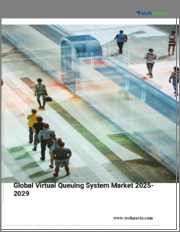
|
시장보고서
상품코드
1721327
세계의 큐 관리 시스템 시장 조사 보고서 : 산업 분석, 규모, 점유율, 성장, 동향, 예측(2025-2033년)Global Queue Management System Market Research Report- Industry Analysis, Size, Share, Growth, Trends and Forecast 2025 to 2033 |
||||||
세계의 큐 관리 시스템 시장 규모는 2024년 6억 3,266만 달러에서 2033년에는 9억 4,344만 달러로 성장하며, 2026-2033년의 예측 기간 중 4.54%의 견고한 연평균 성장률(CAGR)을 보일 것으로 예측됩니다.
대기열 관리 시스템 시장은 기업이 고객 경험과 업무 효율성을 높이는 것이 중요하다는 것을 인식함에 따라 큰 변화의 시기를 맞이하고 있습니다. 디지털 인터랙션의 부상과 간소화된 서비스 제공의 필요성으로 인해 고객 흐름을 최적화하는 대기열 관리 솔루션의 도입이 증가하고 있습니다. 이러한 시스템은 대기 시간을 단축할 뿐만 아니라 서비스 품질을 향상시켜 고객 만족도와 충성도를 높일 수 있습니다. 소비자의 기대치가 계속 진화함에 따라 혁신적인 대기열 관리 솔루션에 대한 수요가 확대되어 시장 확대의 원동력이 될 것으로 예측됩니다.
또한 인공지능 및 머신러닝과 같은 첨단 기술을 대기열 관리 시스템에 통합함으로써 기업이 고객과의 상호 작용을 관리하는 방식에 혁명을 일으키고 있습니다. 이러한 기술은 실시간 데이터 분석을 가능하게 하여 기업이 피크타임을 예측하고 그에 따라 자원을 할당할 수 있게 해줍니다. 데이터베이스 인사이트를 활용함으로써 기업은 업무 효율성을 높이고 원활한 고객 경험을 제공할 수 있습니다. 이러한 추세는 특히 소매, 의료, 서비스업 등 효과적인 대기열 관리가 고객 만족도를 유지하는 데 필수적인 분야에서 더욱 중요하게 작용할 수 있습니다.
또한 전 세계에서 건강에 대한 우려로 인해 비접촉식 솔루션에 대한 관심이 높아지고 있는 것도 대기열 관리 시스템 시장의 미래를 형성하고 있습니다. 조직들은 현재 모바일 체크인, 가상 대기열 시스템 등 물리적 접촉을 최소화하는 솔루션을 우선시하고 있습니다. 이러한 변화는 건강 및 안전에 대한 우려에 대응하는 것뿐만 아니라, 디지털 방식으로 상호 작용하는 것을 선호하는 소비자 증가와도 일치합니다. 대기열 관리 시스템 시장은 기술 혁신과 소비자 행동 변화에 대한 적응이 계속되고 있으므로 기술 발전과 고객 경험 향상에 대한 수요에 힘입어 지속적으로 성장할 것으로 예측됩니다.
당사의 보고서는 고객에게 다양한 산업 및 시장에 대한 종합적이고 실용적인 인사이트를 제공하기 위해 세심하게 작성되었습니다. 각 보고서는 시장 상황을 완전히 이해하기 위해 몇 가지 중요한 요소를 포함하고 있습니다.
시장 개요: 정의, 분류, 산업 현황 등 시장에 대한 자세한 소개.
시장 역학: 시장 성장에 영향을 미치는 주요 촉진요인, 억제요인, 기회 및 과제를 자세히 분석합니다. 이 섹션에서는 기술 발전, 규제 변화, 새로운 동향 등의 요인을 검토합니다.
세분화 분석 : 제품 유형, 애플리케이션, 최종사용자, 지역 등의 기준에 따라 시장을 명확한 부문으로 분류합니다. 이 분석을 통해 각 부문의 성과와 잠재력을 파악할 수 있습니다.
경쟁 구도: 시장 점유율, 제품 포트폴리오, 전략적 구상, 재무 실적 등 주요 시장 기업의 종합적인 평가. 주요 기업이 채택하고 있는 경쟁 역학 및 주요 전략에 대한 인사이트을 제공합니다.
시장 예측 : 과거 데이터와 현재 시장 상황을 바탕으로 일정 기간 중 시장 규모와 성장 추세를 예측합니다. 여기에는 정량적 분석과 미래 시장 궤적을 보여주는 그래프 표시가 포함됩니다.
지역 분석 : 지역별 시장 성과를 평가하고 주요 시장 및 지역 동향을 파악할 수 있습니다. 지역 시장 역학 및 비즈니스 기회를 이해하는 데 도움이 됩니다.
새로운 동향과 기회 : 현재 시장 동향과 새로운 시장 동향, 기술 혁신, 잠재적 투자 대상 분야를 파악합니다. 미래 시장 개발 및 성장 전망에 대한 인사이트를 제공합니다.
목차
제1장 서문
제2장 개요
- 시장의 하이라이트
- 세계 시장 스냅숏
제3장 큐 관리 시스템 산업 분석
- 서론 : 시장 역학
- 시장 성장 촉진요인
- 시장 성장 억제요인
- 시장 기회
- 업계 동향
- Porter's Five Forces 분석
- 시장의 매력 분석
제4장 밸류체인 분석
- 밸류체인 분석
- 원재료 분석
- 원재료 리스트
- 원재료 제조업체 리스트
- 주요 원재료의 가격 동향
- 잠재적 바이어 리스트
- 마케팅 채널
- 다이렉트 마케팅
- 인다이렉트 마케팅
- 마케팅 채널 발전 동향
제5장 세계의 큐 관리 시스템 시장 분석 : 컴포넌트별
- 개요 : 컴포넌트별
- 과거·예측 데이터 분석 : 컴포넌트별
- 하드웨어
- 소프트웨어
- 서비스
- 전문 서비스
제6장 세계의 큐 관리 시스템 시장 분석 : 유형별
- 개요 : 유형별
- 과거·예측 데이터 분석 : 유형별
- 가상 큐잉
- 선형 큐잉
제7장 세계의 큐 관리 시스템 시장 분석 : 배포 모델별
- 개요 : 배포 모델별
- 과거·예측 데이터 분석 : 배포 모델별
- 온프레미스
- 클라우드
제8장 세계의 큐 관리 시스템 시장 분석 : 조직 규모별
- 개요 : 조직 규모별
- 과거·예측 데이터 분석 : 조직 규모별
- 중소기업
- 대기업
제9장 세계의 큐 관리 시스템 시장 분석 : 용도별
- 개요 : 용도별
- 과거·예측 데이터 분석 : 용도별
- 고객 서비스
- 리포팅·분석
- 쿼리 처리
- 실시간 모니터링
- 예약 관리
제10장 세계의 큐 관리 시스템 시장 분석 : 최종사용자별
- 개요 : 최종사용자별
- 과거·예측 데이터 분석 : 최종사용자별
- 소매
- 헬스케어
- 은행
- 정부기관
- 운송
- 교육
- 접객(Hoapitality)
- 기타
제11장 세계의 큐 관리 시스템 시장 분석 : 지역별
- 지역별 전망
- 서론
- 북미의 판매 분석
- 개요, 실적과 예측
- 북미 : 부문별
- 북미 : 국가별
- 미국
- 캐나다
- 멕시코
- 유럽의 판매 분석
- 개요, 실적과 예측
- 유럽 : 부문별
- 유럽 : 국가별
- 영국
- 프랑스
- 독일
- 이탈리아
- 러시아
- 기타 유럽
- 아시아태평양의 판매 분석
- 개요, 실적과 예측
- 아시아태평양 : 부문별
- 아시아태평양 : 국가별
- 중국
- 인도
- 일본
- 한국
- 호주
- 동남아시아
- 기타 아시아태평양
- 라틴아메리카의 판매 분석
- 개요, 실적과 예측
- 라틴아메리카 : 부문별
- 라틴아메리카 : 국가별
- 브라질
- 아르헨티나
- 페루
- 칠레
- 기타 라틴아메리카
- 중동 및 아프리카의 판매 분석
- 개요, 실적과 예측
- 중동 및 아프리카 : 부문별
- 중동 및 아프리카 : 국가별
- 사우디아라비아
- 아랍에미리트
- 이스라엘
- 남아프리카공화국
- 기타 중동 및 아프리카
제12장 큐 관리 시스템 기업의 경쟁 구도
- 큐 관리 시스템 시장의 경쟁
- 제휴·협력·합의
- 합병·인수
- 신제품 발매
- 기타 개발
제13장 기업 개요
- 상위 기업의 시장 점유율 분석
- 시장 집중도
- Advantech
- Lavi Industries
- QLess
- Qmatic
- Qminder Ltd.
- Q-Nomy
- Sigosoft
- Skiplino
- Tensator
- Wavetec
Global Queue Management System Market size is anticipated to grow from USD 632.66 Million in 2024 to USD 943.44 Million by 2033, showcasing a robust Compound Annual Growth Rate (CAGR) of 4.54% during the forecast period of 2026 to 2033.
The queue management system market is experiencing a significant transformation as businesses recognize the importance of enhancing customer experience and operational efficiency. With the rise of digital interactions and the need for streamlined service delivery, organizations are increasingly adopting queue management solutions to optimize customer flow. These systems not only reduce wait times but also improve service quality, leading to higher customer satisfaction and loyalty. As consumer expectations continue to evolve, the demand for innovative queue management solutions is expected to grow, driving market expansion.
Furthermore, the integration of advanced technologies such as artificial intelligence and machine learning into queue management systems is revolutionizing the way businesses manage customer interactions. These technologies enable real-time data analysis, allowing organizations to predict peak times and allocate resources accordingly. By leveraging data-driven insights, businesses can enhance their operational efficiency and provide a seamless customer experience. This trend is particularly relevant in sectors such as retail, healthcare, and hospitality, where effective queue management is crucial for maintaining customer satisfaction.
Additionally, the increasing emphasis on contactless solutions in the wake of global health concerns is shaping the future of the queue management system market. Organizations are now prioritizing solutions that minimize physical contact, such as mobile check-ins and virtual queuing systems. This shift not only addresses health and safety concerns but also aligns with the growing consumer preference for digital interactions. As the queue management system market continues to innovate and adapt to changing consumer behaviors, it is set to thrive, driven by technological advancements and the demand for enhanced customer experiences.
Our reports are meticulously crafted to provide clients with comprehensive and actionable insights into various industries and markets. Each report encompasses several critical components to ensure a thorough understanding of the market landscape:
Market Overview: A detailed introduction to the market, including definitions, classifications, and an overview of the industry's current state.
Market Dynamics: In-depth analysis of key drivers, restraints, opportunities, and challenges influencing market growth. This section examines factors such as technological advancements, regulatory changes, and emerging trends.
Segmentation Analysis: Breakdown of the market into distinct segments based on criteria like product type, application, end-user, and geography. This analysis highlights the performance and potential of each segment.
Competitive Landscape: Comprehensive assessment of major market players, including their market share, product portfolio, strategic initiatives, and financial performance. This section provides insights into the competitive dynamics and key strategies adopted by leading companies.
Market Forecast: Projections of market size and growth trends over a specified period, based on historical data and current market conditions. This includes quantitative analyses and graphical representations to illustrate future market trajectories.
Regional Analysis: Evaluation of market performance across different geographical regions, identifying key markets and regional trends. This helps in understanding regional market dynamics and opportunities.
Emerging Trends and Opportunities: Identification of current and emerging market trends, technological innovations, and potential areas for investment. This section offers insights into future market developments and growth prospects.
SEGMENTATION COVERED IN THE REPORT
By Component
- Hardware
- Software
- Services
- Professional services
By Type
- Virtual queuing
- Linear queuing
By Deployment Model
- On-premises
- Cloud
By Organization Size
- SME
- Large enterprises
By Application
- Customer service
- Reporting & analytics
- Query handling
- Real-time monitoring
- Appointment management
By End User
- Retail
- Healthcare
- Banking
- Government
- Transportation
- Education
- Hospitality
- Others
- COMPANIES PROFILED
- Advantech
- Lavi Industries
- QLess
- Qmatic
- Qminder Ltd.
- Q-nomy
- Sigosoft
- Skiplino
- Tensator
- Wavetec.
- The above list can be customized.
TABLE OF CONTENTS
1. PREFACE
- 1.1. Report Description
- 1.1.1 Objective
- 1.1.2 Target Audience
- 1.1.3 Unique Selling Proposition (USP) & offerings
- 1.2. Research Scope
- 1.3. Research Methodology
- 1.3.1 Market Research Process
- 1.3.2 Market Research Methodology
2. EXECUTIVE SUMMARY
- 2.1. Highlights of Market
- 2.2. Global Market Snapshot
3. QUEUE MANAGEMENT SYSTEM INDUSTRY ANALYSIS
- 3.1. Introduction - Market Dynamics
- 3.2. Market Drivers
- 3.3. Market Restraints
- 3.4. Opportunities
- 3.5. Industry Trends
- 3.6. Poerter's Five Force Analysis
- 3.7. Market Attractiveness Analysis
- 3.7.1 Market Attractiveness Analysis By Component
- 3.7.2 Market Attractiveness Analysis By Type
- 3.7.3 Market Attractiveness Analysis By Deployment Model
- 3.7.4 Market Attractiveness Analysis By Organization Size
- 3.7.5 Market Attractiveness Analysis By Application
- 3.7.6 Market Attractiveness Analysis By End User
- 3.7.7 Market Attractiveness Analysis By Region
4. VALUE CHAIN ANALYSIS
- 4.1. Value Chain Analysis
- 4.2. Raw Material Analysis
- 4.2.1 List of Raw Materials
- 4.2.2 Raw Material Manufactures List
- 4.2.3 Price Trend of Key Raw Materials
- 4.3. List of Potential Buyers
- 4.4. Marketing Channel
- 4.4.1 Direct Marketing
- 4.4.2 Indirect Marketing
- 4.4.3 Marketing Channel Development Trend
5. GLOBAL QUEUE MANAGEMENT SYSTEM MARKET ANALYSIS BY COMPONENT
- 5.1. Overview By Component
- 5.2. Historical and Forecast Data Analysis By Component
- 5.3. Hardware Historic and Forecast Sales By Regions
- 5.4. Software Historic and Forecast Sales By Regions
- 5.5. Services Historic and Forecast Sales By Regions
- 5.6. Professional services Historic and Forecast Sales By Regions
6. GLOBAL QUEUE MANAGEMENT SYSTEM MARKET ANALYSIS BY TYPE
- 6.1. Overview By Type
- 6.2. Historical and Forecast Data Analysis By Type
- 6.3. Virtual queuing Historic and Forecast Sales By Regions
- 6.4. Linear queuing Historic and Forecast Sales By Regions
7. GLOBAL QUEUE MANAGEMENT SYSTEM MARKET ANALYSIS BY DEPLOYMENT MODEL
- 7.1. Overview By Deployment Model
- 7.2. Historical and Forecast Data Analysis By Deployment Model
- 7.3. On-premises Historic and Forecast Sales By Regions
- 7.4. Cloud Historic and Forecast Sales By Regions
8. GLOBAL QUEUE MANAGEMENT SYSTEM MARKET ANALYSIS BY ORGANIZATION SIZE
- 8.1. Overview By Organization Size
- 8.2. Historical and Forecast Data Analysis By Organization Size
- 8.3. SME Historic and Forecast Sales By Regions
- 8.4. Large enterprises Historic and Forecast Sales By Regions
9. GLOBAL QUEUE MANAGEMENT SYSTEM MARKET ANALYSIS BY APPLICATION
- 9.1. Overview By Application
- 9.2. Historical and Forecast Data Analysis By Application
- 9.3. Customer service Historic and Forecast Sales By Regions
- 9.4. Reporting & analytics Historic and Forecast Sales By Regions
- 9.5. Query handling Historic and Forecast Sales By Regions
- 9.6. Real-time monitoring Historic and Forecast Sales By Regions
- 9.7. Appointment management Historic and Forecast Sales By Regions
10. GLOBAL QUEUE MANAGEMENT SYSTEM MARKET ANALYSIS BY END USER
- 10.1. Overview By End User
- 10.2. Historical and Forecast Data Analysis By End User
- 10.3. Retail Historic and Forecast Sales By Regions
- 10.4. Healthcare Historic and Forecast Sales By Regions
- 10.5. Banking Historic and Forecast Sales By Regions
- 10.6. Government Historic and Forecast Sales By Regions
- 10.7. Transportation Historic and Forecast Sales By Regions
- 10.8. Education Historic and Forecast Sales By Regions
- 10.9. Hospitality Historic and Forecast Sales By Regions
- 10.10. Others Historic and Forecast Sales By Regions
11. GLOBAL QUEUE MANAGEMENT SYSTEM MARKET ANALYSIS BY GEOGRAPHY
- 11.1. Regional Outlook
- 11.2. Introduction
- 11.3. North America Sales Analysis
- 11.3.1 Overview, Historic and Forecast Data Sales Analysis
- 11.3.2 North America By Segment Sales Analysis
- 11.3.3 North America By Country Sales Analysis
- 11.3.4 United States Sales Analysis
- 11.3.5 Canada Sales Analysis
- 11.3.6 Mexico Sales Analysis
- 11.4. Europe Sales Analysis
- 11.4.1 Overview, Historic and Forecast Data Sales Analysis
- 11.4.2 Europe By Segment Sales Analysis
- 11.4.3 Europe By Country Sales Analysis
- 11.4.4 United Kingdom Sales Analysis
- 11.4.5 France Sales Analysis
- 11.4.6 Germany Sales Analysis
- 11.4.7 Italy Sales Analysis
- 11.4.8 Russia Sales Analysis
- 11.4.9 Rest Of Europe Sales Analysis
- 11.5. Asia Pacific Sales Analysis
- 11.5.1 Overview, Historic and Forecast Data Sales Analysis
- 11.5.2 Asia Pacific By Segment Sales Analysis
- 11.5.3 Asia Pacific By Country Sales Analysis
- 11.5.4 China Sales Analysis
- 11.5.5 India Sales Analysis
- 11.5.6 Japan Sales Analysis
- 11.5.7 South Korea Sales Analysis
- 11.5.8 Australia Sales Analysis
- 11.5.9 South East Asia Sales Analysis
- 11.5.10 Rest Of Asia Pacific Sales Analysis
- 11.6. Latin America Sales Analysis
- 11.6.1 Overview, Historic and Forecast Data Sales Analysis
- 11.6.2 Latin America By Segment Sales Analysis
- 11.6.3 Latin America By Country Sales Analysis
- 11.6.4 Brazil Sales Analysis
- 11.6.5 Argentina Sales Analysis
- 11.6.6 Peru Sales Analysis
- 11.6.7 Chile Sales Analysis
- 11.6.8 Rest of Latin America Sales Analysis
- 11.7. Middle East & Africa Sales Analysis
- 11.7.1 Overview, Historic and Forecast Data Sales Analysis
- 11.7.2 Middle East & Africa By Segment Sales Analysis
- 11.7.3 Middle East & Africa By Country Sales Analysis
- 11.7.4 Saudi Arabia Sales Analysis
- 11.7.5 UAE Sales Analysis
- 11.7.6 Israel Sales Analysis
- 11.7.7 South Africa Sales Analysis
- 11.7.8 Rest Of Middle East And Africa Sales Analysis
12. COMPETITIVE LANDSCAPE OF THE QUEUE MANAGEMENT SYSTEM COMPANIES
- 12.1. Queue Management System Market Competition
- 12.2. Partnership/Collaboration/Agreement
- 12.3. Merger And Acquisitions
- 12.4. New Product Launch
- 12.5. Other Developments
13. COMPANY PROFILES OF QUEUE MANAGEMENT SYSTEM INDUSTRY
- 13.1. Top Companies Market Share Analysis
- 13.2. Market Concentration Rate
- 13.3. Advantech
- 13.3.1 Company Overview
- 13.3.2 Company Revenue
- 13.3.3 Products
- 13.3.4 Recent Developments
- 13.4. Lavi Industries
- 13.4.1 Company Overview
- 13.4.2 Company Revenue
- 13.4.3 Products
- 13.4.4 Recent Developments
- 13.5. QLess
- 13.5.1 Company Overview
- 13.5.2 Company Revenue
- 13.5.3 Products
- 13.5.4 Recent Developments
- 13.6. Qmatic
- 13.6.1 Company Overview
- 13.6.2 Company Revenue
- 13.6.3 Products
- 13.6.4 Recent Developments
- 13.7. Qminder Ltd.
- 13.7.1 Company Overview
- 13.7.2 Company Revenue
- 13.7.3 Products
- 13.7.4 Recent Developments
- 13.8. Q-Nomy
- 13.8.1 Company Overview
- 13.8.2 Company Revenue
- 13.8.3 Products
- 13.8.4 Recent Developments
- 13.9. Sigosoft
- 13.9.1 Company Overview
- 13.9.2 Company Revenue
- 13.9.3 Products
- 13.9.4 Recent Developments
- 13.10. Skiplino
- 13.10.1 Company Overview
- 13.10.2 Company Revenue
- 13.10.3 Products
- 13.10.4 Recent Developments
- 13.11. Tensator
- 13.11.1 Company Overview
- 13.11.2 Company Revenue
- 13.11.3 Products
- 13.11.4 Recent Developments
- 13.12. Wavetec
- 13.12.1 Company Overview
- 13.12.2 Company Revenue
- 13.12.3 Products
- 13.12.4 Recent Developments



















